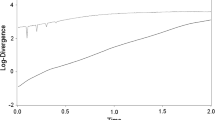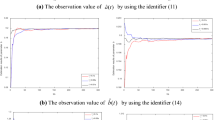Abstract
The problem of sequential filtering of a chaotic random process is considered in the context of the general problem of controlling the state of a dynamic object in an unstable immersion environment. In conditions of chaotic dynamics, traditional sequential processing of observations either does not provide the required level of smoothing, or leads to a significant lagging shift of the estimate of the conditional average. The paper provides a numerical analysis of the effectiveness of algorithms for identifying the system component of chaotic processes based on the terminal indicator of management effectiveness. Several filtering algorithms with improved characteristics according to criteria for smoothing quality and control quality indicators based on the system component isolated from noisy observations are proposed.

















Similar content being viewed by others
Availability of data and material
The data used for the simulation can be provided via email if required.
Code Availability
The MATLAB code used for the simulation can be provided via email if required.
References
Batchelor GK (2000) An introduction to fluid dynamics. Cambridge University Press, Cambridge
Birkhoff G (2015) Hydrodynamics, vol 2234. Princeton University Press, Princeton
Pentek A, Tel T, Toroczkai Z (1996) Transient chaotic mixing in open hydrodynamical flows. Int J Bifurc Chaos 6(12b):2619–2625
Dèdèwanou SJ, Monwanou AV, Koukpémèdji AA, Hinvi LA, Miwadinou CH, Chabi Orou JB (2022) Thermal instability and chaos in a hybrid nanofluid flow. Int J Bifurc Chaos 32(07), 2250102
Kundu PK, Cohen IM, Dowling DR (2015) Fluid mechanics. Academic Press, Cambridge
Oppenheim AV, Wornell GW, Isabelle SH, Cuomo KM (1992) Signal processing in the context of chaotic signals. In: [Proceedings] ICASSP-92: 1992 IEEE international conference on acoustics, speech, and signal processing, vol 4, pp 117–1204. https://doi.org/10.1109/ICASSP.1992.226472
Haykin S, Li XB (1995) Detection of signals in chaos. Proc IEEE 83(1):95–122
Eisencraft M, Attux R, Suyama R (eds) (2018) Chaotic signals in digital communications. CRC Press, Boca Raton
Peters EE (1996) Chaos and order in the capital markets: a new view of cycles, prices, and market volatility, 2nd edn. Wiley, Hoboken
Gregory-Williams J, Williams BM (2004) Trading chaos: maximize profits with proven technical techniques, 2nd edn. Wiley, Hoboken
Kendall MG, A S, Co L (1963) The advanced theory of statistics, 2nd edn. Design and Analysis, and Time Series, vol 2, p 433. Charles Griffin, London
Musaev A, Grigoriev D (2022) Numerical studies of statistical management decisions in conditions of stochastic chaos. Mathematics 10(2):226
Makshanov AV, Musaev AA (2019) Intellectual data analysis. Textbook. Saint Petersburg Institute of technology, Saint Petersburg
Downey AB (2014) Think Bayes: Bayesian Essentials with R, 2nd edn. O’Reilly, Sebastopol, p 310
Stone J (2013) Bayes’ rule: a tutorial introduction to bayesian analysis. Sebtel Press, Sheffield . https://doi.org/10.13140/2.1.1371.6801
Arecchi FT, Boccaletti S, Ciofini M, Meucci R, Grebogi C (1998) The control of chaos: theoretical schemes and experimental realizations 08:1643
Feldman DP (2019) Chaos and dynamical systems. Princeton University Press, Princeton
Rosenthal C, Jones N (2020) Chaos engineering: system resiliency in practice. O’Reilly Media, Sebastopol
Kapitaniak T (1990) Chaos in systems with noise. World Scientific, Singapore
Frey M, Simiu E (1993) Deterministic and stochastic chaos. Comput Stochast Mech 195–216
Faranda D, Sato Y, Saint-Michel B, Wiertel C, Padilla V, Dubrulle B, Daviaud F (2017) Stochastic chaos in a turbulent swirling flow. Phys Rev Lett 119(1):014502
Musaev AA (2010) Quod est veritas. Views transformation at a system component of observable process. Inform Autom 15:53–74
Anderson BDO, Moore JB (2005) Optimal filtering. Dover Publications, Mineola, p 368
Bozic SM (2018) Digital and Kalman filtering: an introduction to discrete-time filtering and optimum linear estimation. Courier Dover Publications, Mineola
Simon D (2006) Optimal state estimation: Kalman, H Infinity, and nonlinear approaches. Wiley, Noboken
Gelb A (1974) Applied optimal estimation. MIT Press, Cambridge, p 374
Stengel RF (1994) Optimal control and estimation. Courier Corporation, Mineola
Nyberg SJ (2018) The Bayesian way: introductory statistics for economists and engineers. Wiley, Hoboken
Chui CK, Chen G (2017) Kalman filtering. Springer, Berlin
Grewall MS, Andrews AP (1993) Kalman filtering. Theory and practice. Prentice Hall, Hoboken
Everette SG Jr (1985) Exponential smoothing: the state of the art. J Forecast 4:1–28
Niederhoffer V, Kenner L (2005) Practical speculation. Wiley, Hoboken
Colby RW, Meyers TA (2012) The encyclopedia of technical market indicators. IRWIN Professional Publishing, Burr Ridge
Musaev A, Makshanov A, Grigoriev D (2022) Numerical studies of channel management strategies for nonstationary immersion environments: Eurusd case study. Mathematics 10(9)
Musaev AA (2014) Statistical analysis of chaotic processes inertia. Inform Autom 2(33):48–59
Musaev A, Grigoriev D (2022) Multi-expert systems: fundamental concepts and application examples. J Theor Appl Inf Technol 100(2):336–348
Funding
The research of Alexander Musaev described in this paper is partially supported by state research FFZF-2022-0004. Dmitry Grigoriev research for this paper was supported by a grant from the Russian Science Foundation (Project No. 22-18-00588).
Author information
Authors and Affiliations
Contributions
Alexander Musaev, Andrey Makshanov and Dmitry Grigoriev have contributed equally to this work.
Corresponding author
Ethics declarations
Conflict of interest
The authors declare no conflict of interest.
Rights and permissions
Springer Nature or its licensor (e.g. a society or other partner) holds exclusive rights to this article under a publishing agreement with the author(s) or other rightsholder(s); author self-archiving of the accepted manuscript version of this article is solely governed by the terms of such publishing agreement and applicable law.
About this article
Cite this article
Musaev, A., Makshanov, A. & Grigoriev, D. Algorithms of sequential identification of system component in chaotic processes. Int. J. Dynam. Control 11, 2566–2579 (2023). https://doi.org/10.1007/s40435-023-01121-9
Received:
Revised:
Accepted:
Published:
Issue Date:
DOI: https://doi.org/10.1007/s40435-023-01121-9




